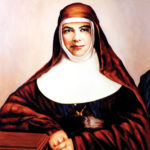Mary Mackillop - a woman for today
Opinion
The daughter of an agnostic poet, educated by Presbyterians, a hard-bitten secular journalist, SAMELA HARRIS asks how on earth did she end up in a world of gentle Roman Catholic Sisters working to make a museum for a saint?

In learning that Mary MacKillop is Australia’s first saint, too many Australians simply pigeonhole her as a Catholic phenomenon. It’s nice, but not their denomination.
That’s why we need a museum!
 Mary MacKillop, aka St Mary of the Cross MacKillop, is not just a saint, she is a feminist icon.
Mary MacKillop, aka St Mary of the Cross MacKillop, is not just a saint, she is a feminist icon.
She was out there setting up women’s refuges a century before the #metoo movement.
She was a woman who stood up for women when women were oppressed or victims of domestic violence.
Advertisement
She was a woman who educated girls when the system discriminated against them. She inculcated them in science as well as the Word of her God. She was a woman who stood up against paedophilia in the Church, a century before it was a public issue. She was a woman who stood up against the bullying patriarchy of the bishops and who was excommunicated for it. She was a woman who dared to go to Rome to put her cause to the Pope in person. She was a woman who rounded up other women, be they educated or lost souls, and gave them a purpose. She was a woman who wished to leave no child without an education.
Need I go on? I can.
Mary MacKillop is the real deal so far as cultural pin-ups go, a national treasure.
It was my father who brought her into my life.
My father, the poet and intellectual Max Harris, grew up in the South East of our State and knew from childhood about Mary MacKillop as a significant part of the regional history, just as he knew about mad Adam Lindsay Gordon who leapt on his horse into the bottomless Blue Lake, or the Penola-born poet John Shaw Neilson.
Among the remarkable men of the South East was Julian Tenison Woods, the handsome scientist priest who worked his vast parish on horseback and was to recognise Mary’s exceptional potential and to become her friend and mentor. It was Woods who invited Mary to set up the wee Penola school and it was Woods who nurtured Mary through the process of starting the Order of St Joseph of the Sacred Heart.
The year was 1866. And thus began the spread of St Joseph’s schools under the tutelage of the Sisters. On horseback, by coach and by foot, they followed farmers and miners, ensuring that rural families had teachers. They lived tough, just as the outback workers did; maybe even tougher, since their vow was to own nothing. It is hard to imagine the privations stoically endured by these dedicated women in their coarse, hot Brown-Joey habits.
My father was an historian and also a feminist. He read biographies of noted women and cared about those whose memories were neglected.
He had always seen Mary MacKillop as a feminist and leader way ahead of her times.
He wrote article after article about her in his role as a columnist with The Australian. He advocated for her national recognition and for her sainthood. He coined the phrase ‘a saint for all Australians’.
Advertisement
The Catholic Church was a bit surprised by all this attention from a lay quarter, I think.
But Mary MacKillop, whose path through life was often fraught and rocky, had always attracted champions from outside the Church. The Scots Presbyterians Joanna and Robert Barr Smith and the Adelaide Jewish merchant Emmanuel Solomon, for instance, were MacKillop stalwarts who were there for her when times were tough.
Mary MacKillop was incapable of bigotry. She sought equal education for Aboriginal children and she accepted lovingly people of all beliefs and backgrounds.
It is notable that even today in her modern schools, one might find Islamic prefects and Buddhist duxes and Hindu sports captains melded happily in among the Catholic student community. Equality, education, understanding.
Mary MacKillop gathered around her an interesting diversity of nuns. There was a core collection who were to take a great deal of responsibility and be anchors to the movement of the Josephites, for lots of things went wrong for Mary and she needed strong loyal women at her side.
These women of different backgrounds all deserve their own recognition and 10 are getting it in the new museum. Visitors will find themselves allocated one of these original Brown Joeys via, of all things, a barcode. And they will follow their paths through sophisticated digital displays.
It is very much in the progressive spirit of Mary that the new museum is to be state-of-the-art with religious relics side-by-side with high-tech apparatus.
The MacKillop Museum will be in the grounds of the convent which used to be her headquarters, whence so much of her expansive educational work was to spread forth, where decisions were made and prayers flew heavenwards. Where conflicts with bishops and the regressive strictures of the Church and its hierarchy and educational theories were thought through, and whence, in disagreement with the nasty Bishop Reynolds, Mary was banished and forced into exile.
Mary’s nuns in Kapunda had blown the whistle on a paedophile priest. Mary supported them. To this day, the nuns and the Church tiptoe around this scandal. As a non-Catholic, I see it as an issue of great pride. Mary and her Josephites stood up for the young and for what was right. These were brave, forthright women. My sort of women.
Today’s Josephites come from the same mould. They are educated, motivated women, still living very simply.
It has been a mission of immense love to get the museum project off the ground. Designers and builders have been offering best possible deals for the nuns.
Mary’s desk will be aloft in the new museum, beneath it arrayed around the display spaces, special treasures and relics, including one on generous loan from the David Roche Foundation. There will be a coffee shop and gift store, of course. Later will come a walking trail around the area where Mary lived and worked.
Ever brave and positive, the Sisters have taken out a loan to get the work underway, hoping for a Government grant down the line.
This museum to Australia’s first canonised saint is expected to gain quite a bit of international as well as national attention as the tourism market fires up on themes of feminism and progress.
Few places on earth could brag a more dazzling star in the firmament of feminism.
To make a donation to the Museum visit www.marymackillopadelaide.org.au









Comments
Show comments Hide comments